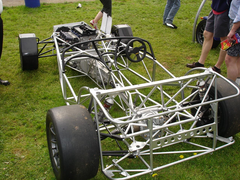Neville Jones
|
| posted on 24/3/10 at 10:26 AM |

|
|
quote:
Originally posted by t.j.
quote:
Originally posted by Neville Jones
None of them pass the Aus torsion and beam test, without some essential tubes added. That includes the latest Cateringvan and Westfields.
Cheers,
Nev.
so what are the values they need to score?
Ignorance is bliss, isn't it?
Production cars are assumed to be compliant (and that they are in more ways than the obvious). ICV's and things like stretched limos need a
torsion and beam test.
Beam test----Max average deflection of 1.25mm difference between loaded and unloaded, with load of 136kg's in each seat position.
Torsion test----Four cylinder/rotary engined vehicle under 1000kg tare mass, 4Nm/degree for each kg tare mass minimum. More than 4 cylinders,
6000Nm/degree minimum. (no weight adjustment/multiplier like the 4 cyls.)
Now you know.
Cheers,
Nev.
|
|
|
|
|
iti_uk
|
| posted on 24/3/10 at 02:03 PM |

|
|
quote:
Ignorance is bliss, isn't it?
Production cars are assumed to be compliant (and that they are in more ways than the obvious). ICV's and things like stretched limos need a
torsion and beam test.
Beam test----Max average deflection of 1.25mm difference between loaded and unloaded, with load of 136kg's in each seat position.
Torsion test----Four cylinder/rotary engined vehicle under 1000kg tare mass, 4Nm/degree for each kg tare mass minimum. More than 4 cylinders,
6000Nm/degree minimum. (no weight adjustment/multiplier like the 4 cyls.)
Now you know.
Cheers,
Nev.
To reiterate with correct units;
4 cyl;
4kNm/deg
5+cyl;
6kNm/deg
From my own experience, I know these cars tend to struggle to manage more than 2kNm/deg torsional stiffness. No wonder they don't pass that
test. It's all down to their geometry and scale - these cars are so lightweight they don't need the stiffness a 1-tonne car requires to
control it's chassis, but target figures are target figures, so they fail. Ah well.
Chris
[Edited on 24/3/2010 by iti_uk]
|
|
|
Liam
|
| posted on 24/3/10 at 02:52 PM |

|
|
quote:
Originally posted by britishtrident
Birkin by a very large margin
What's your criteria, though? Closeness to an original lotus, then yes, though doesn't that mean it's made from thin gauge steel and
has a number of tubes 'missing' over more modern designs which at best means it's a bit wobbly, and at worst prone to failure with
modern tyres and engines? (Or was the S3 that the Birkin reproduces already beefed up?).
For strength and stiffness I reckon a lot of the modern offerings easily beat the more traditional designs. Dax and Donker look good in some areas,
but both compromise the engine bay bracing to allow flexibility of engine fitments. MNR's top spec is another one I really like.
For me it comes back round to Caterham, not for their traditional design, but the CSR which has the best 'seven' chassis I've
seen...
[Edited on 24/3/10 by Liam]
 
Rescued attachment CSR.jpg
|
|
|
Neville Jones
|
| posted on 25/3/10 at 10:25 AM |

|
|
quote:
Originally posted by iti_uk
quote:
Ignorance is bliss, isn't it?
Production cars are assumed to be compliant (and that they are in more ways than the obvious). ICV's and things like stretched limos need a
torsion and beam test.
Beam test----Max average deflection of 1.25mm difference between loaded and unloaded, with load of 136kg's in each seat position.
Torsion test----Four cylinder/rotary engined vehicle under 1000kg tare mass, 4Nm/degree for each kg tare mass minimum. More than 4 cylinders,
6000Nm/degree minimum. (no weight adjustment/multiplier like the 4 cyls.)
Now you know.
Cheers,
Nev.
To reiterate with correct units;
4 cyl;
4kNm/deg
5+cyl;
6kNm/deg
From my own experience, I know these cars tend to struggle to manage more than 2kNm/deg torsional stiffness. No wonder they don't pass that
test. It's all down to their geometry and scale - these cars are so lightweight they don't need the stiffness a 1-tonne car requires to
control it's chassis, but target figures are target figures, so they fail. Ah well.
Chris
[Edited on 24/3/2010 by iti_uk]
To reiterate with correct figures,
Four cylinder/rotary engined vehicle under 1000kg tare mass, 4Nm/degree for each kg tare mass minimum. That's about 2600Nm/degree
for the average locost. Or 2.6kNm/degree for picky pedantic smartarses like the above. 
4k Nm/degree is multitudes more than any racecar can achieve, yet alone a locost!
The rest is verbatim from the govt literature. Take it up with them!
Cheers,
Nev.
|
|
|
Neville Jones
|
| posted on 27/3/10 at 12:34 PM |

|
|
4k Nm/degree is multitudes more than any racecar can achieve, yet alone a locost!
Where's the edit button gone?
That above should read, 4kNm/degree/kg, is multitudes more
|
|
|









